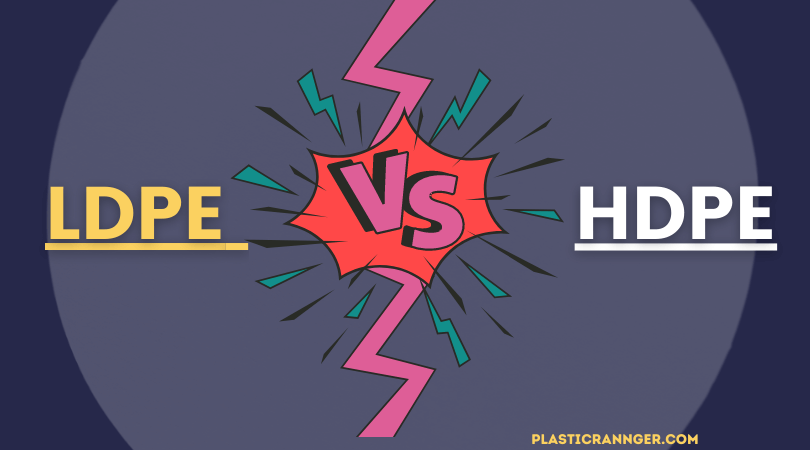Hello people, Today I’m going through the most subtle differences and similarities between LDPE and HDPE.
I have done detailed research through multiple logs, forums, and a few articles published in books to get the most comprehensive information on two of the most renowned plastic materials in human history.
So without further ado, let’s get started.
LDPE Vs HDPE
HDPE offers greater resistance to abrasion and tearing than LDPE, and it boasts superior tensile and shear strength. For underground cable burial, HDPE would be the preferable option. On the other hand, LDPE is a fantastic selection for other applications, as LDPE cable conduits provide remarkable flexibility, extended fatigue life, and strong resistance to impact.
Both HDPE and LDPE belong to the Polyethylene family of thermoplastic materials extracted from petroleum through polymerization.
As we all know, polyethylene is one of the most common and utilized plastics globally.
It has a simple molecular structure, and its applications can be found in everything from children’s toys to grocery bags to water bottles.
Distributively, under the polyethylene class of materials, HDPE (High-density Polyethylene) and LDPE (Low-Density Polyethylene) stand out as they’ve made their way into the packaging and manufacturing industry and transformed them forever into a more affordable and reliable asset.
Here are the basic attributes of the two materials:
- Low-density Polyethylene – The clear or transparent plastic shows incredible chemical resistance, flexibility, and waterproofing capacity. It is utilized to make a wide array of products – the most common applications being flexible packaging material, grocery bags, plastic wrap & films, and injection molded components.
- High-density Polyethylene – The highly popular plastic material exhibits high impact strength and durability.
- It is commercially available in many variations, such as transparent and opaque, and like LDPE, it also demonstrates excellent chemical resistance.
- The most popular HDPE applications include automotive parts, toys, kitchen equipment, pipes, outdoor furniture, and structures.
Although LDPE and HDPE are thermoplastic ethylene polymers, their properties, structure, and uses differ.
One stark distinction between them is that the LDPE is more branched out in its structure than in perfect rows compared to HDPE.
Branching occurs during polymerization, where polymer chains are attached with secondary polymer chains joined to them by replacing an atom in the primary chain with a monomer group.
LDPE Vs HDPE: Properties
| Property | LDPE | HDPE |
| Chemical Structure | More branching | More linear, less branching |
| Flexibility | Low density – 0.91-0.94 g/cm3 | High density – 0.95-0.97 g/cm3 |
| Heat Resistance | A substantial decrease in density when kept through temperatures beyond 20°C | Capable of resisting heat with temperatures more than 100°C |
| Flexibility | Low crystallinity (50-60%), leading to more flexibility | High crystallinity (>90%), therefore, makes it tougher and more rigid |
| Strength | Increased impact strength in cold conditions | High tensile strength and specific strength |
| Transparency | High, because of amorphous condition | Low, due to high crystallinity |
| Chemical Resistance | Resistant to most alcohols, alkalis, and acids; low resistance to oxidizing agents and selected hydrocarbons | Outstanding resistance to acids, alcohols, solvents, and alkalis; low resistance to hydrocarbons |
| Maximum allowable stress at 20°C | 6–17 MPa | 14–32 MPa |
Engaging Read – UHMW Vs. Delrin: A Comprehensive Comparision
Similarities Between LDPE and HDPE

LDPE and HDPE have many similar attributes since they are fundamentally made up of the same polymerized ethylene molecules. Below are similar properties.
- Low material weight
- High impact strength
- High recyclability
- Cost-effectiveness
- Tensile strength ranging from 0.20 to 0.40 N/mm2
- Low cost of manufacturing
- Resistance to chemicals and weathering
The following are the similar characteristics seen in both materials when processed in injection molding:
- Melting Point – 180 ̊ to 280 ̊ C (355 ̊ to 535 ̊ F)
- Rapid injection speeds
- Drying the finished component is not necessary
The materials have several similar applications. Here are some industries using LDPE and HDPE extensively.
- Packaging
- Pipes & Fittings
- Electrical
- Automotive
- Hydraulics & pneumatics
Differences Between LDPE and HDPE
As we discussed the similarities between LDPE and HDPE, now is the time to examine the differences.
Due to different compositions and branching, many attributes within both materials are drastically different.
Differences in Physical Attributes
LDPE is more flexible and softer than HDPE. It is also translucent and has a lower melting point of 115° C.
However, compared to HDPE, it is more likely to rupture under stress.
On the other hand, HDPE is more rigid and durable and offers better chemical resistance.
HDPE melting point is 135°C which is on the higher end, allowing it to resist higher temperatures than LDPE.
In addition, its crystalline structure provides it with greater strength and opacity.
Differences in Molecular Structure
The molecular structure of HDPE is denser and more tightly packed, resulting in a higher density material.
The molecules of HDPE are tightly packed together, giving the material high strength and stiffness.
This also results in lower branching in the molecular chain, contributing to the material’s high melting point and stability.
On the other hand, LDPE has a more loose and flexible molecular structure, resulting in a lower density material.
The molecules of LDPE are more widely spaced, allowing for greater flexibility and ease of processing.
This increased branching in the molecular chain also leads to a lower melting point and more excellent resistance to stress cracking.
Differences in the Production of LDPE and HDPE
How is LDPE produced?
LDPE is produced by either a stirred autoclave or a tubular reactor.
Its general manufacturing process involves the compression of ethylene gas, polymerization using an initiator, and gas separation.
How is HDPE produced?
HDPE is produced by heating the petroleum at very high temperatures using slurry or gas-phase polymerization.
The process begins with polymerizing a solution of ethylene monomers after operation and drying.
Differences in Processing of LDPE and HDPE
The thermoplastic can be very quickly processed in the following methods:
Injection Molding
The injection molding process transforms LDPE or HDPE granules into custom shapes and sizes determined by the mold.
First, the granules are sent to a hot barrel, from which the materials are liquified or melted through a screw barrel and heater bands.
The molten plastic is injected into a pre-designed mold cavity, which cools down the material.
After the material is solidified, it is ejected from the injection molding machine.
Blow Molding
This processing method is utilized to manufacture hollow-shaped plastic components.
Rather than injecting the molten plastic, blow molding uses compressed air to blow the material into the mold.
Extrusion
The Extrusion method also uses heat to melt the plastic granules, like injection molding.
However, the difference is seen in the final part of the machine, where instead of going through the mold, the melted plastic goes through a pre-designed opening and is then cooled down to solidify.
Differences in Recyclability
Both LDPE and HDPE are recyclable, but recycling for both should be done separately.
LDPE is categorized under recycling number 4, and HDPE under recycling number 2.
Although it heavily depends on the product, recycling LDPE can be challenging due to its softness; it will likely get stuck in the machinery.
On the side, HDPE is easier to recycle and transport thanks to its hardness.
Engaging Read – Plastics Vs. Polymers | The Finest Comparision
Advantages & Disadvantages of HDPE and LDPE
| Advantages | Disadvantages | |
| LDPE |
|
|
| HDPE |
|
|
HDPE vs LDPE: Applications
LDPE
- Wash bottles
- Plastic bottles
- Computer hardware covers and packaging
- Light packaging materials
- Corrosion protection layer for work surfaces
HDPE
- Automotive parts like fuel tanks
- Pipes and fittings
- Boat parts
- Plastic chairs and tables
- Consumer products: ice cube containers, trash, and recycling bins, ice chest, toys
- Fibers for ropes, industrial fabrics, and nets
- Packaging materials: bottle caps, plastic milk bottles, drums, and bulk containers for industrial use.
Fascinating Read – Plexiglass Vs. Acrylic | A Comprehensive Comparison
FAQs

Here are some frequently asked questions regarding the distinction between LDPE and HDPE. Let’s delve into the details to gain a deeper understanding.
Is LDPE cheaper than HDPE?
Yes. LDPE is cheaper than HDPE owing to the lower impact strength and chemical resistance than HDPE. However, the price difference between both is not very substantial.
Can HDPE and LDPE be mixed?
Unlike other polymers, HDPE and LDPE can be mixed. However, to be recycled together, it’s better to separate them to maintain their specific properties and get the best results.
What dissolves HDPE?
The most useful solvents for dissolving HDPE are trichlorobenzene, trichloroethylene, tetralin, Benzene, and toluene. But if you want less hazardous options, then toluene, xylene, and trichloroethylene are good choices.
Why is HDPE called the best food-grade plastic?
HDPE is called the best food-safe plastic. It is given the FDA symbol “2”. HDPE is one of the most stable and inert forms of plastic with corrosion resistance and less moisture absorbent, making it the best choice for any food-storing application.
What to Choose, LDPE or PET bottles?
Hands down, PET is the best material for manufacturing all types of bottles, but sometimes using LDPE bottles makes more sense. LDPE is a more squeezable material making, dispensing sauces, honey, creams, condiments, and syrups. It is also better at withstanding colder temperatures than PET.
Suggested Read
- When Was Plastic Invented? | The History of Plastics
- How is Plastic Made? A Simple and Detailed Explanation.
- What is Liquid Plastic? | Liquid Plastic Vs. Resin | An In-Depth Guide
- Top 10 High Impact Resistant Plastics
- What is UHMW Plastic Material? | The Definitive Guide
Final Thoughts
In conclusion, HDPE vs LDPE are two types of polyethylene with different molecular structures and properties. HDPE is characterized by its high density, strength, and stability, making it suitable for applications that require high strength and toughness.
On the other hand, LDPE is known for its flexibility, low-temperature resistance, and ease of processing, making it ideal for applications requiring flexibility and sealability.
The choice between HDPE and LDPE depends on the application’s specific requirements and careful consideration of the properties of each material.
Kindly share your thoughts and question in the comment box.
Have a Phenomenal day.
Quick Navigation


So so useful.
Extremely informative article.
May Allah bless you.
Thank You Very Much